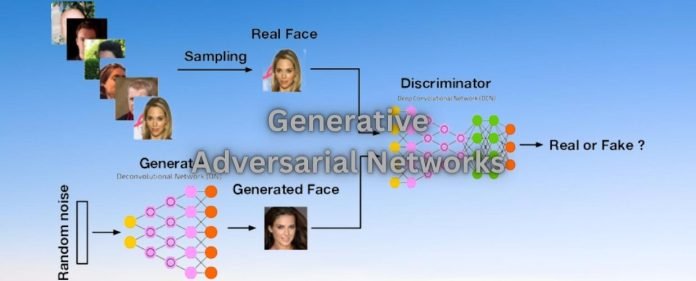In the rapidly evolving realm of artificial intelligence and machine learning, one paradigm stands out as a transformative force in creativity: Generative Adversarial Networks (GANs). These networks have forged an unprecedented alliance between AI and artistry, empowering machines to create content that blurs the lines between reality and imagination. This comprehensive exploration embarks on a captivating journey into the universe of GANs, unraveling their definition, intricate mechanics, wide-ranging applications, notable challenges, and profound impact in reshaping the boundaries of AI-powered creativity.
Defining Generative Adversarial Networks (GANs)
At their core, Generative Adversarial Networks (GANs) represent a class of artificial neural networks that orchestrate a symphony of creativity through a duel of two neural entities: the generator and the discriminator. The generator conjures synthetic data, while the discriminator distinguishes between authentic and synthesized data. The dynamic interplay between these two networks initiates a captivating training process, with the generator refining its craft to generate data virtually indistinguishable from accurate data. This vibrant dance continually challenges the discriminator’s discerning prowess.
How GANs Function
Generative Adversarial Networks (GANs) are a type of neural network that functions by training two models simultaneously: a generator and a discriminator.
- Generator Network: The journey commences with the generator network. It takes random noise as its muse and crafts data, often manifesting as images it believes are authentic representations. The generated data might exhibit raw and unpolished attributes in the nascent stages.
- Discriminator Network: Simultaneously, the discriminator network strides onto the stage. Armed with the ability to evaluate data fed into its neural corridors, the discriminator distinguishes between genuine and synthetic samples. As the training advances, the discriminator hones its acumen, becoming increasingly proficient at deciphering accurate data from the generator’s output.
- Training Process: The essence of GANs lies in their iterative dance. The generator’s proficiency unfurls like a masterpiece over time while the discriminator’s task grows more complex. The generator aspires to conjure data that eludes the discriminator’s ability to restrict between genuine and synthetic origins.
- Convergence: The pinnacle of this artful confrontation emerges when the generator’s output is so exquisitely authentic that even the discriminator falters in its judgment. This harmonious equilibrium signifies the zenith of GAN training, birthing a generator of unparalleled capabilities.
Applications of GANs
Generative Adversarial Networks have numerous applications in various fields, such as art, design, and entertainment.
- Image Synthesis: GANs have orchestrated a paradigm shift in image generation. They have ushered in an era of crafting high-resolution, photorealistic visuals that find applications spanning art, design, and entertainment, catalyzing the creation of awe-inspiring imagery.
- Style Transfer: The creative palette of GANs extends to style transfer. It empowers the transmutation of artistic styles from one image to another, breathing life into visuals that carry the distinctive artistic brushstrokes of renowned creators.
- Data Augmentation: In the tapestry of machine learning, it shines as data augmentation instruments. By conjuring synthetic data, they enrich the training dataset, amplifying the performance of learning models and engendering robustness.
- Face Aging and Transformation: The realm of GANs ventures into facial metamorphosis. These networks simulate the aging process of faces, bestow images with the stylistic essence of revered artists, and even birth entirely fictional countenances.
Challenges of GANs
Despite their many benefits, Generative Adversarial Networks also come with their own set of challenges. One of the biggest challenges is achieving stability in the training process, as GANs can be prone to instability and mode collapse.
- Training Instability: The choreography of training GANs is intricate and challenging. Achieving the delicate equilibrium between the generator and discriminator networks can yield instability, manifesting as fluctuations in the learning process or even failure to converge.
- Mode Collapse: Within the captivating realm of GANs, mode collapse emerges as an intriguing yet formidable hurdle. This phenomenon materializes when the generator hones in on producing a limited subset of outputs that fool the discriminator. Regrettably, this output fails to encapsulate the diversity inherent in the training data.
- Evaluation Metrics: The quest to gauge generated content quality remains a puzzle. Traditional metrics often need to be more accurate in accurately encapsulating generated samples’ subjective quality and artistic essence.
Future of GANs
The field of generative adversarial networks is brimming with potential. Researchers are actively working to overcome training stability and mode collapse challenges, fueling this exciting technology’s advancement. One area of particular interest is the evolution of conditional GANs, which allow input conditions to guide the generator’s output. This innovation has opened up new avenues for creative exploration, pushing the boundaries of what is possible with paving the way for uncharted realms of creation.
Conclusion
Generative Adversarial Networks embody a monumental leap in artificial intelligence capabilities. By orchestrating a duel between the generator and the discriminator, it infuses machines with the spirit of creativity. Their influence ripples across domains – from crafting art and images to simulating faces and transmuting styles, they have unfurled a vista of possibilities that challenge human ingenuity’s boundaries. Amidst the challenges, the potential of GANs to redefine how content is conceived, generated, and experienced is irrefutable.



